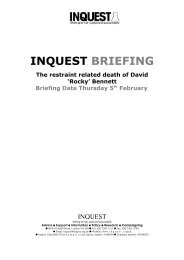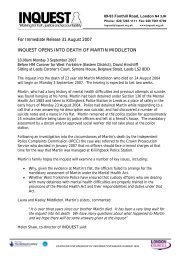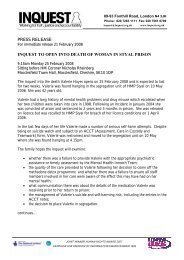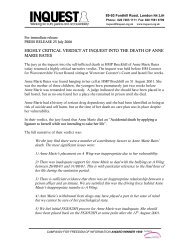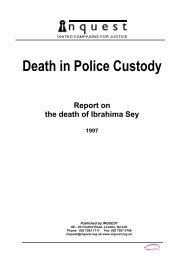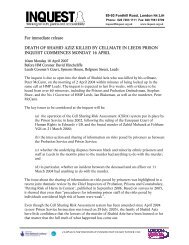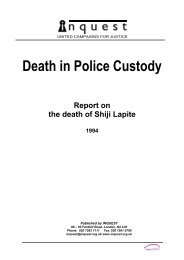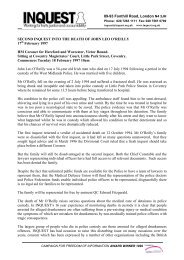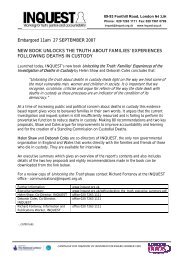INQUEST's briefing on the death of Kenneth Severin
INQUEST's briefing on the death of Kenneth Severin
INQUEST's briefing on the death of Kenneth Severin
Create successful ePaper yourself
Turn your PDF publications into a flip-book with our unique Google optimized e-Paper software.
UNITED CAMPAIGNS FOR JUSTICEDeath in Pris<strong>on</strong> CustodyReport <strong>on</strong><strong>the</strong> <strong>death</strong> <strong>of</strong> <strong>Kenneth</strong> <strong>Severin</strong>1995Published by INQUEST89 – 93 F<strong>on</strong>thill Road, L<strong>on</strong>d<strong>on</strong>, N4 3JHPh<strong>on</strong>e: 020 7263 1111 Fax: 020 7561 0799inquest@inquest.org.uk www.inquest.org.uk
Death in Pris<strong>on</strong> Custody – Report <strong>on</strong> <strong>the</strong> <strong>death</strong> <strong>of</strong> <strong>Kenneth</strong> <strong>Severin</strong>THE DEATH OF KENNETH SEVERINThe ill treatment and subsequent <strong>death</strong> <strong>of</strong> remand pris<strong>on</strong>er <strong>Kenneth</strong> <strong>Severin</strong> whilst being restrained by pris<strong>on</strong> <strong>of</strong>ficers in Belmarshpris<strong>on</strong> raises serious human rights issues.His <strong>death</strong> revealed c<strong>on</strong>cerns in <strong>the</strong> following areas:• <strong>the</strong> use <strong>of</strong> pris<strong>on</strong> for those with mental health problems;• <strong>the</strong> standard <strong>of</strong> treatment and care <strong>of</strong> those with severe mental health problems in pris<strong>on</strong>;• <strong>the</strong> standard <strong>of</strong> health care provided by <strong>the</strong> Pris<strong>on</strong> Medical Service;• <strong>the</strong> poor communicati<strong>on</strong> between Mental Health services and <strong>the</strong> courts;• <strong>the</strong> stereotyping <strong>of</strong> black men with mental health problems within <strong>the</strong> criminal justice system;• <strong>the</strong> use <strong>of</strong> punishment as opposed to care for <strong>the</strong> disturbed within Belmarsh pris<strong>on</strong>;• <strong>the</strong> adequacy <strong>of</strong> <strong>the</strong> inquest for investigating such <strong>death</strong>s;• <strong>the</strong> failure <strong>of</strong> <strong>the</strong> Pris<strong>on</strong> Ombudsman to investigate <strong>death</strong>s in pris<strong>on</strong>• <strong>the</strong> failure <strong>of</strong> <strong>the</strong> Pris<strong>on</strong> Service to make public <strong>the</strong> internal pris<strong>on</strong> inquiry• <strong>the</strong> failure <strong>of</strong> <strong>the</strong> Pris<strong>on</strong> Service to learn from previous <strong>death</strong>s following <strong>the</strong> use <strong>of</strong> c<strong>on</strong>trol and restraintIntroducti<strong>on</strong><strong>Kenneth</strong> <strong>Severin</strong> was a 25 year old African Caribbean man with serious mental health problems who was remanded to Belmarshpris<strong>on</strong> by <strong>the</strong> magistrates court - a decisi<strong>on</strong> which cost him his life. He had never been in pris<strong>on</strong> before and was remanded for an<strong>of</strong>fence <strong>of</strong> attempted burglary after he had tried to gain entry to a house in which he had <strong>on</strong>ce lived. At <strong>the</strong> time <strong>of</strong> his arrest in <strong>the</strong>early hours <strong>of</strong> 31.10.95 he was homeless - his council flat having been burnt out and vandalised. Past diagnoses had suggested hewas suffering from paranoid schizophrenia and he was suffering mental health difficulties at <strong>the</strong> time <strong>of</strong> <strong>the</strong> <strong>of</strong>fence. Despite beingknown to <strong>the</strong> local Mental Health Team and having a Community Psychiatric Nurse he did not receive <strong>the</strong> help and support heneeded in order to enable him to live safely in <strong>the</strong> community.Police and court experienceOn his arrest by police he was taken to Greenwich police stati<strong>on</strong> for interview. Police accepted that he was mentally ill and <strong>the</strong>y<strong>the</strong>refore arranged for an appropriate adult to attend <strong>the</strong> police stati<strong>on</strong> for his interview. C<strong>on</strong>tact was also made with his communitypsychiatric nurse who did not tell <strong>the</strong> police that <strong>Kenneth</strong> was suffering from schizophrenia but assumed <strong>the</strong> police realised he wasmentally ill. He was charged and refused bail <strong>on</strong> <strong>the</strong> basis that he had no address to go to and '...for his own protecti<strong>on</strong> as he doesnot always appear to know what he is doing' (Custody record) He appeared at Greenwich magistrates court <strong>on</strong> 1 st November 1995and was described in court as a paranoid schizophrenic. No bail applicati<strong>on</strong> was made <strong>on</strong> his behalf <strong>on</strong> <strong>the</strong> basis that <strong>the</strong>re was littleknown about him and <strong>the</strong>re was nowhere for him to go. <strong>Kenneth</strong> was <strong>the</strong>refore subsequently remanded to HMP Belmarsh. He nextappeared at <strong>the</strong> magistrates court <strong>on</strong> 8 th November. The duty psychiatrist was unable to see him as he had to leave early. A bailapplicati<strong>on</strong> was made but refused by <strong>the</strong> Magistrate <strong>on</strong> <strong>the</strong> basis that because <strong>of</strong> his mental c<strong>on</strong>diti<strong>on</strong> <strong>the</strong>re was a likelihood <strong>of</strong> himnot appearing at Court. The matter was adjourned for seven days for him to see <strong>the</strong> duty psychiatrist. On 15 th November <strong>Kenneth</strong>again appeared at Greenwich Magistrates Court where he saw <strong>the</strong> Duty psychiatrist who declared him fit to plead and stand trial. Afull bail applicati<strong>on</strong> was again made but refused.Pris<strong>on</strong> experience<strong>Kenneth</strong> was first remanded to Belmarsh pris<strong>on</strong> from Greenwich magistrates court <strong>on</strong> 11 th October 1995 and following a recepti<strong>on</strong>screening interview with a pris<strong>on</strong> doctor he was located in <strong>the</strong> health care centre because <strong>of</strong> this mental health difficulties. Despite<strong>Kenneth</strong>'s mental health history <strong>on</strong>e <strong>of</strong> <strong>the</strong> main issues to emerge about <strong>the</strong> health care centre was that bizarre or disruptivebehaviour was seen by pris<strong>on</strong> staff as a discipline and c<strong>on</strong>trol problem ra<strong>the</strong>r than a medical issue. Prior to his <strong>death</strong> in pris<strong>on</strong> <strong>on</strong>25 th November he was charged with two spectacularly trivial <strong>of</strong>fences and subject to two adjudicati<strong>on</strong>'s :Firstly for refusing to movehis cup etc. from <strong>the</strong> observati<strong>on</strong> hatch when ordered to do so and sec<strong>on</strong>dly by allegedly being abusive to a pris<strong>on</strong> <strong>of</strong>ficer by saying"Stop switching <strong>of</strong>f my light you arsehole". Despite being identified as a paranoid schizophrenic a Medical <strong>of</strong>ficer assessed him asbeing fit for adjudicati<strong>on</strong> and cellular c<strong>on</strong>finement.On <strong>the</strong> night <strong>of</strong> his <strong>death</strong> pris<strong>on</strong> <strong>of</strong>ficers were called to <strong>the</strong> Health Care Centre after being informed that a pris<strong>on</strong>er had beenswinging a 'line' from his cell window to <strong>Kenneth</strong> <strong>Severin</strong>'s cell. Use <strong>of</strong> a 'line' was a relatively comm<strong>on</strong> occurrence in pris<strong>on</strong> wherebytorn strips <strong>of</strong> sheeting or o<strong>the</strong>r material is swung between cells to pass articles such as magazines, tobacco, matches etc. and alsoc<strong>on</strong>traband including drugs. <strong>Kenneth</strong> was never asked about <strong>the</strong> 'line' and it was simply removed from <strong>the</strong> o<strong>the</strong>r inmate’s cell.© INQUEST 2000. Please credit INQUEST when using this material for purposes <strong>of</strong> quotati<strong>on</strong>.2
Death in Pris<strong>on</strong> Custody – Report <strong>on</strong> <strong>the</strong> <strong>death</strong> <strong>of</strong> <strong>Kenneth</strong> <strong>Severin</strong>At night in <strong>the</strong> Health Care Centre <strong>the</strong>re were two medically qualified staff <strong>on</strong> duty as well as discipline staff. A doctor was available<strong>on</strong> call. Nurse Ward had some c<strong>on</strong>tact with <strong>Kenneth</strong> shortly before midnight when he asked for some cakes and some sugar, whichshe gave to him. She did not know he was a schizophrenic. She had never had any c<strong>on</strong>tact with him before but said that <strong>the</strong>re wasnothing about his behaviour that gave her any cause for c<strong>on</strong>cern. About <strong>on</strong>e and a half hours later she was asked by <strong>the</strong> seniorhealth worker to go and see <strong>Kenneth</strong>. She was not told why nor was she given any informati<strong>on</strong> about his medical history and <strong>the</strong> factthat he was mentally ill as he did not see this as relevant. She did not look at any medical records. She noticed a marked differencein him from her previous c<strong>on</strong>tact and said that he was hostile and shouting. She managed to calm him down by <strong>the</strong> time she left himand had no c<strong>on</strong>cerns about him being at any risk <strong>of</strong> harming himself.Principal <strong>of</strong>ficer Bens<strong>on</strong> was <strong>the</strong> most senior <strong>of</strong>ficer in <strong>the</strong> pris<strong>on</strong> that night and effectively in charge. He was c<strong>on</strong>tacted by <strong>of</strong>ficers<strong>on</strong> duty in <strong>the</strong> hospital wing at about 00:55 saying that <strong>Kenneth</strong> was causing a disturbance by shouting and banging <strong>on</strong> his door. Heand three <strong>of</strong>ficers including a dog handler went to <strong>the</strong> health centre where <strong>the</strong>y were informed that <strong>Kenneth</strong> had been agitated since22:00 that evening. He went to his cell to talk to him and said that he was shouting 'I shouldn't be here.' 'See <strong>the</strong> judge', 'Let me gohome' and also o<strong>the</strong>r incoherent things. PO Bens<strong>on</strong> accepted that <strong>Kenneth</strong>'s behaviour was bizarre but he knew nothing about himnor did he seek to find out any informati<strong>on</strong> from medical staff. He did not c<strong>on</strong>sider it appropriate to have any medical input in <strong>the</strong>decisi<strong>on</strong> to relocate <strong>Kenneth</strong> into strip c<strong>on</strong>diti<strong>on</strong>s despite <strong>the</strong> <strong>of</strong>ficial guidelines stressing that this should be <strong>the</strong> case. According tohis records <strong>Kenneth</strong> had been agitated for at least <strong>the</strong> previous three hours but nursing staff were not aware <strong>of</strong> this. All pris<strong>on</strong><strong>of</strong>ficers insisted that <strong>the</strong> strip cells were never used as punishment and justified <strong>the</strong>ir decisi<strong>on</strong> to locate <strong>Kenneth</strong> in strips by virtue <strong>of</strong>his being <strong>of</strong> potential harm to himself. At no time had any medical or discipline staff c<strong>on</strong>sidered him to be a suicide risk.It is unclear whe<strong>the</strong>r any<strong>on</strong>e explained to <strong>Kenneth</strong> that he was being moved to a strip cell but a struggle started when he was told hecould not take his pers<strong>on</strong>al stereo with him. Such was <strong>the</strong> struggle that it took five <strong>of</strong>ficers to restrain him using techniques called'C<strong>on</strong>trol and Restraint'. He was placed in ratchet cuffs behind his back and taken according to <strong>of</strong>ficers still struggling via a lift to astrip cell <strong>on</strong> <strong>the</strong> upper floor <strong>of</strong> <strong>the</strong> health care centre. In <strong>the</strong> strip cell seven <strong>of</strong>ficers were involved with <strong>the</strong> restraint <strong>of</strong> <strong>Kenneth</strong> wherehe was placed face down still handcuffed <strong>on</strong>to a mattress. He was <strong>the</strong>n totally stripped <strong>of</strong> his lower body clothing and his handcuffswere removed as were his upper body clo<strong>the</strong>s c<strong>on</strong>trary to <strong>the</strong> pris<strong>on</strong> regulati<strong>on</strong>s which state " A pris<strong>on</strong>er may be deprived <strong>of</strong> normalclo<strong>the</strong>s <strong>on</strong>ly if, in <strong>the</strong> light <strong>of</strong> <strong>the</strong> individual case this is c<strong>on</strong>sidered essential to prevent self injury or injury to o<strong>the</strong>rs". (1)Pris<strong>on</strong> <strong>of</strong>ficers said it was standard practice to strip any pris<strong>on</strong>er going to a strip cell and could not justify this practice in <strong>the</strong> pris<strong>on</strong>rules or guidelines. (2) His pulse was checked <strong>on</strong>ce and <strong>the</strong>n again because <strong>of</strong> c<strong>on</strong>cern at his stillness. It was apparently fine. Thepris<strong>on</strong> <strong>of</strong>ficers <strong>the</strong>n left <strong>the</strong> cell . Because he was so still <strong>the</strong> senior nurse was called who found him naked, lying <strong>on</strong> his stomach, hishands in <strong>the</strong> same positi<strong>on</strong> as <strong>the</strong>y would have been when <strong>the</strong> handcuffs were removed. An ambulance was called but all attemptsto resuscitate him failed.All <strong>of</strong>ficers involved in <strong>the</strong> c<strong>on</strong>trol and restraint denied <strong>the</strong> use <strong>of</strong> excessive force, <strong>the</strong> use <strong>of</strong> a neck hold or <strong>the</strong> applicati<strong>on</strong> <strong>of</strong> anypressure <strong>on</strong> <strong>the</strong> back. They were all unable to explain <strong>the</strong> deep bruising over <strong>the</strong> back found at <strong>the</strong> two post mortems. N<strong>on</strong>e <strong>of</strong> <strong>the</strong>pris<strong>on</strong> <strong>of</strong>ficers who gave evidence had received any training in <strong>the</strong> potential dangers <strong>of</strong> c<strong>on</strong>trol and restraint in particular placingsome<strong>on</strong>e face down with <strong>the</strong>ir hands handcuffed behind <strong>the</strong>ir back. Even more disturbing was <strong>the</strong> fact that <strong>the</strong> <strong>of</strong>ficer resp<strong>on</strong>sible forC<strong>on</strong>trol and Restraint training had never heard <strong>of</strong> positi<strong>on</strong>al asphyxia until his attendance <strong>on</strong> <strong>the</strong> day <strong>of</strong> <strong>the</strong> inquest and was not surewhy <strong>the</strong>re was a potential danger in placing a pris<strong>on</strong>er in such a positi<strong>on</strong>. A circular instructi<strong>on</strong> issued in 1993 although it formed part<strong>of</strong> <strong>the</strong> C<strong>on</strong>trol and Restraint manual had not filtered down to <strong>of</strong>ficers who regularly used such techniques or even to <strong>the</strong> trainer. Thecircular had been issued as a result <strong>of</strong> c<strong>on</strong>cerns expressed about c<strong>on</strong>trol and restraint at <strong>the</strong> inquest into <strong>the</strong> <strong>death</strong> <strong>of</strong> OmasaseLumumba who died in 1991 in Pent<strong>on</strong>ville pris<strong>on</strong> after being restrained. A new circular instructi<strong>on</strong> was issued <strong>on</strong> <strong>the</strong> 16 th December1996 less than two weeks before <strong>the</strong> inquest which n<strong>on</strong>e <strong>of</strong> <strong>the</strong> <strong>of</strong>ficers including <strong>the</strong> trainer had seen or been made aware <strong>of</strong>.All pris<strong>on</strong> <strong>of</strong>ficers involved in <strong>the</strong> restraint <strong>of</strong> <strong>Kenneth</strong> <strong>Severin</strong> referred to <strong>the</strong> 'superhuman' and 'incredible strength' <strong>of</strong> <strong>Kenneth</strong>. Theyall denied that <strong>the</strong>y had used unnecessary force and c<strong>on</strong>tended that <strong>the</strong>y had followed <strong>the</strong> guidelines <strong>on</strong> c<strong>on</strong>trol and restraint to <strong>the</strong>book.The <strong>on</strong>ly n<strong>on</strong> pris<strong>on</strong> pers<strong>on</strong>nel accounts <strong>of</strong> <strong>the</strong> incident were two pris<strong>on</strong>ers Peter and (no relati<strong>on</strong>) Paul J<strong>on</strong>es. Peter J<strong>on</strong>es was <strong>on</strong><strong>the</strong> lower floor <strong>of</strong> <strong>the</strong> health care centre in <strong>the</strong> cell next to <strong>Kenneth</strong> he heard shouting and banging from <strong>the</strong> cell . He went to sleepand later heard <strong>the</strong> sound <strong>of</strong> o<strong>the</strong>r voices who he assumed were pris<strong>on</strong> <strong>of</strong>ficers. He heard different noises which he inferred was<strong>Kenneth</strong> being beaten up and heard him shouting 'Call <strong>the</strong> police, call <strong>the</strong> police.’ He said that his cell hatch was open and that hesaw <strong>Kenneth</strong> not struggling and being dragged away by pris<strong>on</strong> <strong>of</strong>ficers.Paul J<strong>on</strong>es was <strong>on</strong> <strong>the</strong> upper floor <strong>of</strong> <strong>the</strong> health care centre and recalled <strong>Kenneth</strong> shouting up for matches, tobacco and cigarettepapers. Later he heard a door being opened downstairs and <strong>Kenneth</strong> shouting, 'Leave me al<strong>on</strong>e I haven't d<strong>on</strong>e anything and 'Nomore please’. He later saw <strong>Kenneth</strong> being walked <strong>on</strong> <strong>the</strong> upper floor past his window.© INQUEST 2000. Please credit INQUEST when using this material for purposes <strong>of</strong> quotati<strong>on</strong>.3
Death in Pris<strong>on</strong> Custody – Report <strong>on</strong> <strong>the</strong> <strong>death</strong> <strong>of</strong> <strong>Kenneth</strong> <strong>Severin</strong>Dr Jerreat, a pathologist who performed a first post mortem <strong>on</strong> behalf <strong>of</strong> <strong>the</strong> cor<strong>on</strong>er c<strong>on</strong>cluded that no drugs or alcohol hadc<strong>on</strong>tributed to <strong>death</strong>. He noted deep bruising over <strong>the</strong> back which he c<strong>on</strong>cluded were most likely due to pressure <strong>on</strong> <strong>the</strong> back ra<strong>the</strong>rthan from blows or kicks. There was also some bruising to <strong>the</strong> neck. He was satisfied that <strong>the</strong> cause <strong>of</strong> <strong>death</strong> was due to asphyxia asa result <strong>of</strong> <strong>the</strong> positi<strong>on</strong> that <strong>Kenneth</strong> was restrained in combined with pressure being exerted <strong>on</strong> <strong>the</strong> back. A sec<strong>on</strong>d post mortemcarried out <strong>on</strong> behalf <strong>of</strong> <strong>the</strong> family by Dr Hunt agreed with Dr Jerreat's c<strong>on</strong>clusi<strong>on</strong> as to <strong>the</strong> cause <strong>of</strong> <strong>death</strong>. The pris<strong>on</strong> serviceinstructed a third pathologist to review <strong>the</strong> o<strong>the</strong>r two reports and comment about possible causes <strong>of</strong> <strong>death</strong>. He accepted thatalthough o<strong>the</strong>r more unusual causes could not be excluded <strong>the</strong> most likely cause was positi<strong>on</strong>al asphyxia. He though disagreed with<strong>the</strong> o<strong>the</strong>r two pathologists regarding <strong>the</strong> deep bruising to <strong>the</strong> back which he c<strong>on</strong>sidered was most likely due to muscle tearing duringa struggle.VerdictThe Cor<strong>on</strong>er left three possible verdicts for <strong>the</strong> jury to bring back, accident, and open which would be returned <strong>on</strong> <strong>the</strong> balance <strong>of</strong>probabilities and unlawful killing. (The verdict <strong>of</strong> unlawful killing has to be bey<strong>on</strong>d reas<strong>on</strong>able doubt a very difficult verdict for a jury tobring when <strong>the</strong> <strong>death</strong> has occurred within a closed instituti<strong>on</strong> and witnesses to <strong>the</strong> <strong>death</strong> are pris<strong>on</strong> staff.) The jury went out <strong>on</strong>Friday 10 th January 1997 and <strong>on</strong> M<strong>on</strong>day 13 th January reached a majority decisi<strong>on</strong> <strong>of</strong> 9:2 that <strong>the</strong> cause <strong>of</strong> <strong>death</strong> was positi<strong>on</strong>alasphyxia following struggle and restraint during relocati<strong>on</strong> and returned an open verdict. The cor<strong>on</strong>er made seven very str<strong>on</strong>grecommendati<strong>on</strong>s and described <strong>the</strong> “appalling state <strong>of</strong> affairs” surrounding this case.The verdict highlights <strong>the</strong> fact that <strong>the</strong> jury in rejecting <strong>the</strong> authorised versi<strong>on</strong> <strong>of</strong> events <strong>of</strong> all pris<strong>on</strong> <strong>of</strong>ficers showed <strong>the</strong>y had gravereservati<strong>on</strong>s about <strong>the</strong> <strong>of</strong>ficers’ account and <strong>Kenneth</strong>'s treatment in pris<strong>on</strong> and that <strong>the</strong>y were not satisfied that <strong>the</strong> <strong>death</strong> was'accidental'.The inquest systemAs in <strong>the</strong> case <strong>of</strong> every <strong>death</strong> in custody in England and Wales, a Cor<strong>on</strong>er’s inquest was c<strong>on</strong>vened in fr<strong>on</strong>t <strong>of</strong> a jury. There had beena police investigati<strong>on</strong> into <strong>the</strong> <strong>death</strong> and <strong>the</strong> file was passed to <strong>the</strong> Crown Prosecuti<strong>on</strong> Service who decided that <strong>the</strong>re wasinsufficient evidence to bring charges. There was also an internal pris<strong>on</strong> investigati<strong>on</strong> <strong>the</strong> c<strong>on</strong>tents <strong>of</strong> which are never made public.An inquest is <strong>the</strong> <strong>on</strong>ly opportunity that a bereaved family has to inquire into <strong>the</strong> circumstances <strong>of</strong> a relative’s <strong>death</strong>.(3) Inquests into<strong>death</strong>s in c<strong>on</strong>troversial circumstances are complex legal processes that require specialised legal preparati<strong>on</strong> and representati<strong>on</strong>.The system <strong>of</strong> legal aid does not extend to representati<strong>on</strong> at inquests so that ordinary people, in this case <strong>the</strong> bereaved have t<strong>of</strong>inance <strong>the</strong>ir own representati<strong>on</strong> while unlimited public funds allow a team <strong>of</strong> lawyers to represent <strong>the</strong> pris<strong>on</strong> service whilst <strong>the</strong> pris<strong>on</strong><strong>of</strong>ficers and nursing staff are represented from uni<strong>on</strong> or pr<strong>of</strong>essi<strong>on</strong>al associati<strong>on</strong> funding. (4) There is also no disclosure <strong>of</strong>documentati<strong>on</strong> to <strong>the</strong> family <strong>of</strong> <strong>the</strong> deceased before <strong>the</strong> inquest despite <strong>the</strong> recommendati<strong>on</strong> <strong>of</strong> <strong>the</strong> previous Chief Inspector OfPris<strong>on</strong>s Judge Stephen Tumim that all parties should enter <strong>the</strong> inquest with <strong>the</strong> same informati<strong>on</strong>. The inequality in access torepresentati<strong>on</strong> and documentati<strong>on</strong> at inquests is unacceptable and severely inhibits <strong>the</strong> fairness <strong>of</strong> <strong>the</strong> inquest process.The inquest has a very narrow remit and it is manifestly not a public inquiry. It is c<strong>on</strong>cerned primarily with <strong>the</strong> medical cause <strong>of</strong> <strong>death</strong>and c<strong>on</strong>sequently <strong>the</strong> range <strong>of</strong> issues <strong>of</strong> c<strong>on</strong>cern to <strong>the</strong> family could not be properly explored at <strong>the</strong> inquest. Following <strong>the</strong> inquest,c<strong>on</strong>siderati<strong>on</strong> was given to any possible legal acti<strong>on</strong> but it was decided by lawyers that all legal remedies had been exhausted.INQUEST wrote to <strong>the</strong> Pris<strong>on</strong>s Ombudsman as <strong>the</strong> independent body that can investigate complaints against <strong>the</strong> Pris<strong>on</strong> Service torequest that <strong>the</strong>y investigate this case because <strong>the</strong>re were a lot <strong>of</strong> issues that needed to be explored. The Ombudsman replied,indicating that while he was very sympa<strong>the</strong>tic to our request he could not investigate <strong>the</strong> complaint because firstly, part <strong>of</strong> <strong>the</strong> casec<strong>on</strong>cerns <strong>the</strong> clinical judgement <strong>of</strong> doctors, which is specifically excluded from his remit, and a sec<strong>on</strong>d and potentially more importantobstacle was that he had no remit to investigate complaints about a pris<strong>on</strong>ers’ treatment from third parties which rules out <strong>the</strong> family<strong>of</strong> <strong>the</strong> deceased.The Parliamentary OmbudsmanINQUEST has been working with <strong>Kenneth</strong> <strong>Severin</strong>’s MP John Austin about <strong>the</strong> many issues <strong>of</strong> c<strong>on</strong>cern in this case. We have asked<strong>the</strong> Home Secretary Jack Straw to c<strong>on</strong>sider extending <strong>the</strong> remit <strong>of</strong> <strong>the</strong> Pris<strong>on</strong>s Ombudsman so that he can accept complaints fromthird parties i.e. <strong>the</strong> next <strong>of</strong> kin <strong>of</strong> those who die in custody.In <strong>the</strong> absence <strong>of</strong> any o<strong>the</strong>r mechanism to raise our c<strong>on</strong>cerns INQUEST complained to <strong>the</strong> Parliamentary Ombudsman which looksinto misfeasance and maladministrati<strong>on</strong> in public <strong>of</strong>fice. In a damming report (6) <strong>the</strong> Ombudsman expresses particular c<strong>on</strong>cernsabout pris<strong>on</strong> health care and <strong>the</strong> treatment <strong>of</strong> a mentally ill man.© INQUEST 2000. Please credit INQUEST when using this material for purposes <strong>of</strong> quotati<strong>on</strong>.4
Death in Pris<strong>on</strong> Custody – Report <strong>on</strong> <strong>the</strong> <strong>death</strong> <strong>of</strong> <strong>Kenneth</strong> <strong>Severin</strong>“..Mr <strong>Severin</strong> received no more care than would have been accorded to a pris<strong>on</strong>er in <strong>the</strong> main pris<strong>on</strong> despite <strong>the</strong> fact tha<strong>the</strong> was mentally ill and had accordingly been located in <strong>the</strong> health care centre. I c<strong>on</strong>clude that a combinati<strong>on</strong> <strong>of</strong> inadequatehealth care staffing and inadequate communicati<strong>on</strong> between n<strong>on</strong>-health care and health care staff denied Mr <strong>Severin</strong>medical c<strong>on</strong>siderati<strong>on</strong> at <strong>the</strong> time when he most needed it, and allowed less well judged approaches to <strong>the</strong> situati<strong>on</strong> toprevail. That merits my str<strong>on</strong>gest criticism. “)The report also criticised failings at a local and nati<strong>on</strong>al level within <strong>the</strong> Pris<strong>on</strong> Service to ensure that pris<strong>on</strong> <strong>of</strong>ficers were properlytrained in <strong>the</strong> dangers <strong>of</strong> c<strong>on</strong>trol and restraint.“ … <strong>the</strong> [Pris<strong>on</strong> Service] were slow to alert pris<strong>on</strong> Governors fully to <strong>the</strong> danger <strong>of</strong> positi<strong>on</strong>al asphyxia; <strong>the</strong>y failed totranslate such warnings as <strong>the</strong>y gave into adequate instructi<strong>on</strong>s for <strong>the</strong>ir training staff; and <strong>the</strong> training arrangements atBelmarsh failed to keep <strong>of</strong>ficers up to date regarding such limited modificati<strong>on</strong>s as were made. The result was that in 1995Mr <strong>Severin</strong> was dealt with in <strong>the</strong> same way as he would have been in 1990, despite <strong>the</strong> <strong>death</strong>s which had occurred in <strong>the</strong>meantime. That was a deeply unsatisfactory state <strong>of</strong> affairs.”The report is also highly critical <strong>of</strong> <strong>the</strong> c<strong>on</strong>tinuing failure by <strong>the</strong> pris<strong>on</strong> service to disclose to <strong>the</strong> family a copy <strong>of</strong> <strong>the</strong> internalinvestigati<strong>on</strong> report. The Ombudsman found Ms Coles’ complaints about <strong>the</strong> treatment <strong>of</strong> <strong>Kenneth</strong> <strong>Severin</strong> in Belmarsh pris<strong>on</strong> and<strong>the</strong> failure <strong>of</strong> <strong>the</strong> Pris<strong>on</strong> Service to disclose <strong>the</strong> internal inquiry report “fully justified”.CommentThe treatment and care <strong>of</strong> <strong>Kenneth</strong> is an indictment <strong>of</strong> <strong>the</strong> way <strong>the</strong> criminal justice system deals with <strong>the</strong> mentally disordered<strong>of</strong>fender. From his first c<strong>on</strong>tact with police Home Office guidelines make it quite clear that he should have been diverted fromcustody from <strong>the</strong> outset. (7)It dem<strong>on</strong>strates <strong>the</strong> total inadequacy and inappropriateness <strong>of</strong> pris<strong>on</strong> for <strong>the</strong> mentally ill and shows what dangerous places pris<strong>on</strong>sare for such a vulnerable group <strong>of</strong> people. The use <strong>of</strong> c<strong>on</strong>trol and restraint <strong>on</strong> some<strong>on</strong>e who is mentally ill can <strong>on</strong>ly exacerbatesome<strong>on</strong>e's distress. To be forcibly restrained and stripped naked by seven pris<strong>on</strong> <strong>of</strong>ficers can <strong>on</strong>ly be described as brutal andterrifying, inhuman and degrading treatment.The inquest revealed a total lack <strong>of</strong> communicati<strong>on</strong> between medical and discipline staff where <strong>the</strong> medical welfare <strong>of</strong> pris<strong>on</strong>ers inBelmarsh Health Care Centre was given low priority. The <strong>death</strong>s <strong>of</strong> Germain Alexander (1989, Brixt<strong>on</strong> pris<strong>on</strong>) and OmasaseLumumba (1991 Pent<strong>on</strong>ville pris<strong>on</strong>) following <strong>the</strong> use <strong>of</strong> restraint resulted in inquest verdicts <strong>of</strong> neglect and unlawful killing where <strong>the</strong>use <strong>of</strong> c<strong>on</strong>trol and restraint was a central issue. The inquest into <strong>the</strong> <strong>death</strong> <strong>of</strong> <strong>Kenneth</strong> <strong>Severin</strong> failed to establish why <strong>the</strong> dangers <strong>of</strong>positi<strong>on</strong>al asphyxia had not been communicated to every pris<strong>on</strong> <strong>of</strong>ficer. It dem<strong>on</strong>strates <strong>the</strong> failure <strong>of</strong> <strong>the</strong> Pris<strong>on</strong> service to resp<strong>on</strong>d toprevious <strong>death</strong>s and issue clear guidelines and training in acceptable methods <strong>of</strong> restraint.The damming criticism by <strong>the</strong> Parliamentary Ombudsman is a vindicati<strong>on</strong> <strong>of</strong> what INQUEST has been saying for years about <strong>the</strong>secrecy that surrounds <strong>the</strong> investigative process following a pris<strong>on</strong> <strong>death</strong> and <strong>the</strong> failure <strong>of</strong> <strong>the</strong> Pris<strong>on</strong> service to learn <strong>the</strong> less<strong>on</strong>s. Itis <strong>the</strong> first public acknowledgement by a public body that resp<strong>on</strong>sibility for <strong>the</strong> <strong>death</strong> rests with <strong>the</strong> pris<strong>on</strong> service. The failure todisclose <strong>the</strong> internal inquiry highlights <strong>the</strong> complacency and c<strong>on</strong>tempt that <strong>the</strong> Pris<strong>on</strong> service dem<strong>on</strong>strates following pris<strong>on</strong> <strong>death</strong>sand gives us no c<strong>on</strong>fidence that it is committed to openness, transparency and accountability.<strong>Kenneth</strong> <strong>Severin</strong> was <strong>on</strong>e <strong>of</strong> three young black men to die while being restrained in pris<strong>on</strong> between October and December 1995.Dennis Stevens died in HMP Dartmoor <strong>on</strong> 18 th October 1995 (inquest held December 1997) and Alt<strong>on</strong> Manning died in HMPBlakenhurst <strong>on</strong> 8 th December 1995 (inquest held from 12 th January to 25 th March 1998) INQUEST made a detailed submissi<strong>on</strong> to<strong>the</strong> United Nati<strong>on</strong>s CERD Committee (5) <strong>on</strong> our c<strong>on</strong>cerns about <strong>the</strong> number <strong>of</strong> black people dying in custody and our c<strong>on</strong>cerns at <strong>the</strong>disproporti<strong>on</strong>ate number <strong>of</strong> young black men who die in suspicious circumstances. These c<strong>on</strong>cerns have also been expressed byHuman Rights Watch and <strong>the</strong> Rapporteur <strong>on</strong> Torture. No criminal or disciplinary charges have been brought against any <strong>of</strong>ficerinvolved in <strong>the</strong>se cases.Notes1. Pris<strong>on</strong> standing Order 3E paragraph 24(3) December 19902. Pris<strong>on</strong> Authority standing Order 3E, Secti<strong>on</strong> B 3(1) states that <strong>the</strong> unfurnished cells may be used for <strong>the</strong> temporary c<strong>on</strong>finement<strong>of</strong> a violent or refractory pris<strong>on</strong>er <strong>on</strong>ly if "<strong>the</strong> use <strong>of</strong> such accommodati<strong>on</strong> is necessary to prevent <strong>the</strong> pris<strong>on</strong>er causing self injury,injuring ano<strong>the</strong>r pris<strong>on</strong>er or staff, or damaging property or creating a serious disturbance.." .....no pris<strong>on</strong>er shall be c<strong>on</strong>fined in[such a cell] as punishment".© INQUEST 2000. Please credit INQUEST when using this material for purposes <strong>of</strong> quotati<strong>on</strong>.5
Death in Pris<strong>on</strong> Custody – Report <strong>on</strong> <strong>the</strong> <strong>death</strong> <strong>of</strong> <strong>Kenneth</strong> <strong>Severin</strong>3. The family <strong>of</strong> <strong>Kenneth</strong> <strong>Severin</strong> were referred to INQUEST by <strong>the</strong> Greenwich Acti<strong>on</strong> Committee Against Racial Attacks. INQUESTarranged for solicitor Mark Scott to take <strong>on</strong> <strong>the</strong> case and arranged for eminent barrister Edward Fitzgerald QC to represent <strong>the</strong>family for free at <strong>the</strong> inquest. The inquest was c<strong>on</strong>vened at Southwark Cor<strong>on</strong>er’s Court <strong>on</strong> January 2 nd and lasted ten days4. The pris<strong>on</strong> service were represented by a QC and Junior counsel and had <strong>the</strong> treasury solicitor in attendance. Both <strong>the</strong> Pris<strong>on</strong>Officers Associati<strong>on</strong> and <strong>the</strong> RCN instructed Counsel to represent <strong>the</strong>m.5. INQUEST report to <strong>the</strong> United Nati<strong>on</strong>s ‘Racial Discriminati<strong>on</strong> And Deaths In Custody’ 19966. The Parliamentary Ombudsman’s Report March 19997. Government policy states that "...those suffering from mental disorder who require specialist medical treatment or social supportshould receive it from health or social services. Detenti<strong>on</strong> in pris<strong>on</strong> is likely to be damaging to <strong>the</strong> mental health <strong>of</strong> a mentally illpers<strong>on</strong> and <strong>the</strong> Pris<strong>on</strong> service is not equipped to provide treatment."INQUEST works directly with <strong>the</strong> families <strong>of</strong> those who die in custody. It m<strong>on</strong>itors <strong>death</strong>s in custody - in police custody, pris<strong>on</strong>s,immigrati<strong>on</strong> detenti<strong>on</strong> centres, as well as <strong>the</strong> inquiries held into <strong>the</strong>m. INQUEST aims to raise public awareness about c<strong>on</strong>troversial<strong>death</strong>s, and campaigns for <strong>the</strong> necessary changes to improve <strong>the</strong> investigatory process, increase accountability <strong>of</strong> state <strong>of</strong>ficials andavert fur<strong>the</strong>r <strong>death</strong>s.© INQUEST 2000. Please credit INQUEST when using this material for purposes <strong>of</strong> quotati<strong>on</strong>.6



